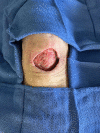Surgical management of a local angioinvasive fungal soft tissue infection in the knee: a case report
- PMID: 35035876
- PMCID: PMC8755634
- DOI: 10.1093/jscr/rjab546
Surgical management of a local angioinvasive fungal soft tissue infection in the knee: a case report
Abstract
A 58-year-old male with an insignificant past medical history presented with chronic myelogenous leukemia in blast crisis. He began induction chemotherapy complicated by neutropenic fever. The patient then developed a nontender 1.5 cm violaceous firm indurated papule above the left patella with satellite lesions on his wrist and chest. A biopsy of the left patella showed obliterated blood vessels in the deep reticular dermis and numerous hyphae with septation and acute angle branching in the vessel wall consistent with angioinvasive aspergillosis. He was started on liposomal amphotericin and empiric voriconazole. Urgent local surgical excision of the primary lesion was recommended for source control. There is no clear recommendation on surgical intervention for angioinvasive aspergillosis, and further direction is needed. We present a case that illustrates surgical debridement for angioinvasive aspergillosis to be an effective method of source control along with systemic antifungal therapy.
Published by Oxford University Press and JSCR Publishing Ltd. All rights reserved. © The Author(s) 2022.
Figures
References
-
- Mays SR, Bogle MA, Bodey GP. Cutaneous fungal infections in the oncology patient: recognition and management. Am J Clin Dermatol. 2006;7:31–43. - PubMed
-
- Shields BE, Rosenbach M, Brown-Joel Z, Berger AP, Ford BA, Wanat KA. Angioinvasive fungal infections impacting the skin: Background, epidemiology, and clinical presentation. J Am Acad Dermatol. 2019;80:869–880.e5. - PubMed
-
- Berger AP, Ford BA, Brown-Joel Z, Shields BE, Rosenbach M, Wanat KA. Angioinvasive fungal infections impacting the skin: Diagnosis, management, and complications. J Am Acad Dermatol. 2019;80:883–898.e2. - PubMed
-
- Loloi J, Saadi R, Williams N, McGinn J. Cutaneous Angioinvasive Fungal Infection of the Auricle. Ear Nose Throat J. 2020;99:173–4. - PubMed
Publication types
LinkOut - more resources
Full Text Sources
Research Materials
Miscellaneous





